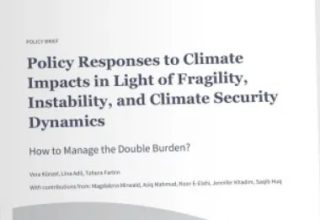
One of the significant challenges that Bangladesh faces is ensuring food security of a growing population. The most viable and holistic solution to this problem is regenerative agriculture. Although the term may not sound familiar to many, it has become a game-changing initiative to sustain agriculture worldwide.
Regenerative agriculture is a farming system that attempts to conserve soil and contribute to multiple provisioning, regulating and supporting services of the ecosystem. And it aims to enhance the environmental, social and economic sustainability of food production. Some practices that are included in regenerative agriculture are diverse crop rotation, no-till/ direct seeding, cover cropping, compost/ manure application, livestock integration, and agroforestry.
Regenerative agriculture can also be considered as a Nature-based Solution (NbS). The International Union for Conservation of Nature (IUCN) defines NbS as “actions to protect, sustainably manage, and restore natural or modified ecosystems that address societal challenges effectively and adaptively, simultaneously providing human well-being and biodiversity benefits.”
Ecosystem based approaches such as agroecology, silvopasture, agroforestry, aquaculture, pasture cropping, biochar, and holistic planned grazing are all regenerative agriculture that falls under the umbrella of NbS. These practices help in ecosystem restoration, ecosystem-based adaptation, mitigation, disaster risk reduction, integrated water resource management, and area-based conservation.
Despite being a densely populated nation that is prone to climate vulnerability, Bangladesh has made various efforts in trying to be prosperous, sustainable, and more resilient to climate change. The country has already taken necessary measures to ensure food security.
People have been practising NbS in Bangladesh for many decades. A rich body of knowledge exists in Bangladesh on how to implement NbS to adapt to climatic impacts. To optimise the positive effects of NbS, the country has implemented a number of projects related to swamp forest restoration, coastal afforestation, floating agriculture, slope vegetation, and many more.

However, if the country is practising NbS then why pay specific attention to regenerative agriculture? The answer is to achieve agriculture sustainability for the long run. This can only be ensured when soil health is improved and prioritised while contributing to improving water and air quality, storing carbon to help mitigate the effects of climate change, and enhancing ecosystem biodiversity.
Methods of regenerative agriculture increase the amount of arable topsoil. It improves soil’s physical properties by decreasing soil compaction, improving aggregate stability, and enhances the chemical quality of soil by increasing their nitrogen and phosphorus content, and increasing exchangeable potassium, sodium, and magnesium.
This form of agriculture also increases the biological quality of soils by substantially increasing soil organic carbon, particulate organic carbon, particulate organic nitrogen contents, and positively affects soil microbial respiration as an indicator for soil biological activity. Causing positive impact to the environment while not compromising crop’s nutritional status, regenerative agriculture is a pre-eminent option for ensuring food security in Bangladesh.
Practices that are incorporated in regenerative agriculture can assist Bangladesh in tackling climate change vulnerability and high population food demands in the future. For example, diverse crop rotation and livestock integration will keep producing food year-round.
Diversification helps improve regulating and supporting ecosystem services such as soil fertility and health, pest control, pollination, nutrient cycling, water regulation, and buffering of temperature extremes. An example of diversification is legume diversification which can be effective for both mitigation and adaptation. Legume diversification does this by reducing the use of nitrogen derived from fossil fuels and providing ecosystem services through nutrient cycling, increasing soil biological activity and erosion control.
As a result, the time adoption of crop diversification can mediate yield stability and decrease the risk of crop loss. Agroforestry practices such as leguminous trees that improve soil fertility and microclimate, no/low tillage or crop residue retention, and organic amendments – in addition to traditional and locally adapted mixed cropping, may increase diversity in soil biological organisms which can contribute to building resilience to multiple stresses such as pest control and drought.
Agriculture has always played an important role in Bangladesh in terms of GDP. The rising population of Bangladesh and decreasing available arable lands will increasingly threaten food security. In a time when we need to be more climate resilient and have sustainable development, giving importance to soil health is crucial.
Soil plays a key role in absorbing carbon and filtering water. The causes of soil destruction include deforestation which increases erosion, chemical-heavy farming techniques, and climate change. Despite High Yielding Varieties (HYV) of crops, chemical fertilisers and pesticides under subsidised rate, extension of irrigation facilities, mechanisation, the country still faces various challenges in sustainable agriculture development.
Bangladesh has incorporated techniques and tools to sustain soil health, but a more progressive step needs to be taken to make it effectively sustainable. Regenerative agriculture combines all the safe practices from previous and new innovative farming methods to keep the soil healthy and sustainable for the future. This agricultural method can be designed and decided according to socio-economic and environmental context.
The established practice of tillage systems, use of chemical fertilisers and pesticides, market design of the current agriculture system cannot be changed drastically as it will affect production and cause confusion among the farmers and related stakeholders.
By studying different geographic contexts and current practices of agriculture, a slow transition needs to be planned and executed to incorporate regenerative agriculture through knowledge generation and capacity building of farmers, relevant institutions and stakeholders.
Hence, a gradual transition with context-based application of the kind of regenerative agriculture that can be used to ensure food security and reduce the environmental impacts and climate change vulnerability must be implemented.
Originally this article was published on 24 April, 2022 at THE BUSINESS STANDARD .
About The Authors
Md. Bodrud-Doza is the Manager at the International Centre for Climate Change and Development (ICCCAD) at Independent University, Bangladesh (IUB). Email: bodrud.doza@icccad.org
Suraiah Khan is a Junior Research Officer at the ICCCAD at IUB. Email: suraiah.khan@icccad.org



















